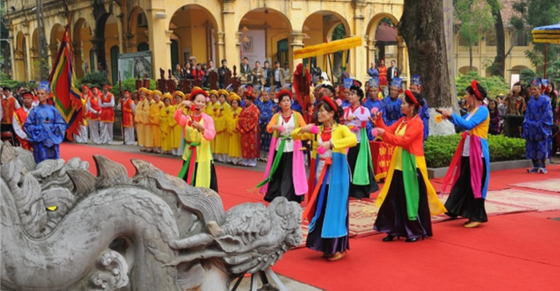Guidelines for Organizing the Inventory of Intangible Cultural Heritage from July 1, 2024
Conducting an inventory of intangible cultural heritage assets is stipulated in Decree No. 39/2024/ND-CP dated April 16, 2024.

Guidelines for Organizing the Inventory of Intangible Cultural Heritage from July 1, 2024 (Image from the Internet)
On April 16, 2024, the Government of Vietnam issued Decree 39/2024/ND-CP stipulating measures to manage, protect, and promote the value of intangible cultural heritage in UNESCO Lists and the national list of intangible cultural heritage.
Guidelines for Organizing the Inventory of Intangible Cultural Heritage from July 1, 2024
Article 6 of Decree 39/2024/ND-CP stipulates the organization of the inventory of intangible cultural heritage as follows:
Inventory of intangible cultural heritage shall be carried out for the following 07 types of heritage:
- Language and script including cultural expressions of the community, conveyed through language and characters to transmit information, knowledge, memories, and cultural and social values of the community;
- Folklore literature including cultural expressions of the community, manifested through creations practiced by the community, such as stories, legends, anecdotes, epics, fables, jokes, humorous stories, folk songs, proverbs, and other similar cultural expressions transmitted orally through generations, reflecting the culture, habits, beliefs, and perceptions of the community to serve directly various activities in communal life;
- Traditional performing arts including cultural expressions of the community, manifested through expressive forms created and practiced by the community such as music, singing, dancing, theater performances, and other performance forms, originating from cultural, spiritual, and production life of the community and directly serving the cultural expression and enjoyment needs of the community;
- Social practices and beliefs including cultural expressions of the community, practiced by the community through regular ritual activities, methods of expressing individual or communal beliefs or desires associated with significant events, perceptions of the world, history, and memories;
- Traditional festivals including multiple ritual cultural expressions created and practiced by the community; practiced cyclically within related cultural space to achieve functions such as understanding nature and society, educating character, adjusting behavior, communication between humans and nature, as well as among humans, serving public entertainment, and ensuring the continuity of history;
- Traditional crafts including cultural expressions represented through the practical, creative activities of artisans and communities using manual methods with techniques, forms, decorations, arts, and local materials passed down from generation to generation to create unique products reflecting the cultural identity of the community;
- Traditional knowledge including cultural expressions of the community formed from historical interactions between the community and the natural and social environment to adapt, survive, and manifest through experiences, knowledge, and skills for flexible, harmonious interaction with nature and society.
Contents of the inventory of intangible cultural heritage include:
- Identifying and determining the name of the heritage;
- Identifying and determining the type of heritage;
- Identifying the locality and distribution range of the heritage; for intangible cultural heritage present in multiple locations within the same province or centrally controlled city, specify down to the ward, commune, or commune-level town;
- Identifying and determining the heritage holders:
For individual heritage holders: identify their full name, age, ethnicity, occupation, address, and related information about the heritage practice process.
For community or group heritage holders: identify the full name, age, ethnicity, occupation, address, and related information about the heritage practice process of the representatives of that community or group.
- Identifying the birth and continuity process of the intangible cultural heritage; manifestation forms, expression forms, practice processes, related architecture, artifacts, and cultural space, along with the material and spiritual products created during the heritage practice process;
- Identifying and determining the current state of heritage practice, maintenance ability, factors affecting the heritage's existence, risks, and causes of degradation of the intangible cultural heritage;
- Identifying, determining, and evaluating historical, cultural, scientific values and the role of the intangible cultural heritage in contemporary community life;
- Proposing protection measures;
- Compiling a bibliography of documents related to the intangible cultural heritage, including publications, field survey documents, and other materials;
- Other legal regulations related to intangible cultural heritage.
The inventory timeline is as follows:
- For intangible cultural heritage in the Representative List: once every 06 (six) years or as per other UNESCO regulations;
- For intangible cultural heritage in the Urgent Safeguarding List: once every 04 (four) years or as per other UNESCO regulations;
- For intangible cultural heritage in the national list: once every 03 (three) years from the time of inscription.
See more at Decree 39/2024/ND-CP effective from June 1, 2024.
To Quoc Trinh
- Construction of works on road currently in use in Vietnam according to the latest regulations
- From January 1, 2025, an additional case where female employees in Vietnam may take up to 6 months off
- Regulations on the use of land for road safely corridor in Vietnam from 2025
- Guidelines for determining specific land prices using the land price adjustment coefficient method in Vietnam from August 1, 2024
- Maximum fine of 1 million VND for confusing customers regarding price listings in Vietnam
- From January 1, 2025, 13 cases where drivers must observe, slow down, or stop in Vietnam
-

- Conditions for Granting Operational Licenses for ...
- 18:00, 27/07/2024
-

- Conditions for Graduation Recognition and Issuance ...
- 17:30, 27/07/2024
-

- Regulations on Setting Construction Boundary Markers ...
- 17:00, 27/07/2024
-

- Construction of works on road currently in use ...
- 16:30, 27/07/2024
-

- Ministry of Health Requires Enhanced Responsibilities ...
- 16:04, 27/07/2024
 Article table of contents
Article table of contents
